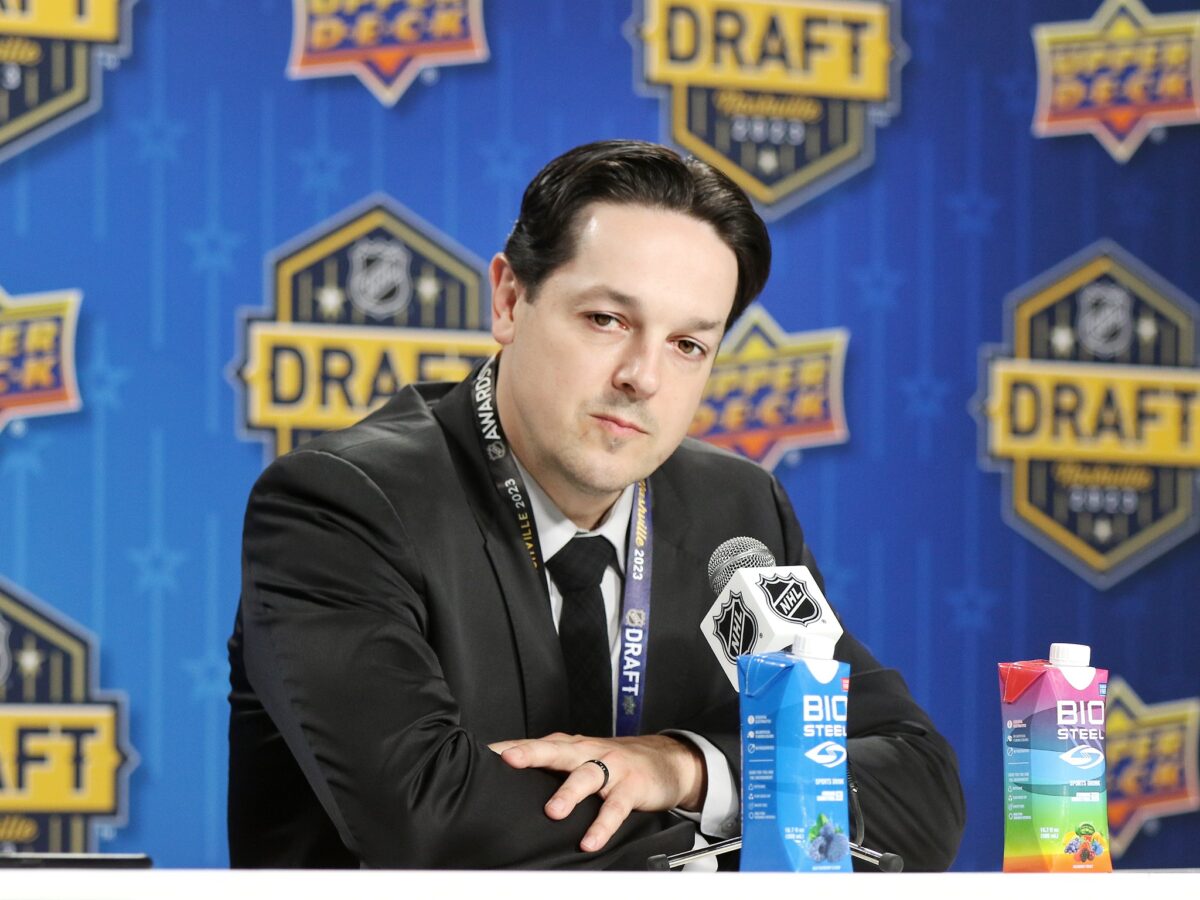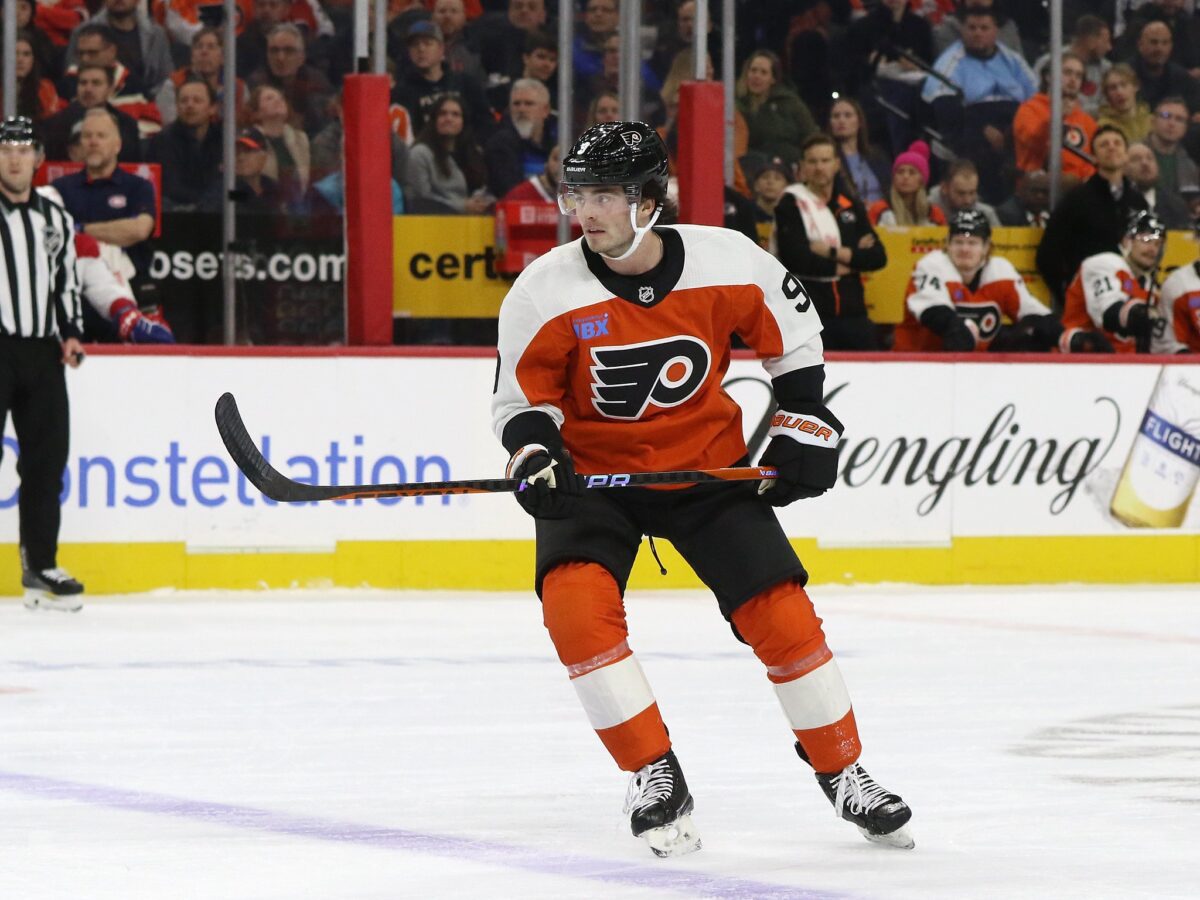The Philadelphia Flyers look to mostly be done in their 2024 offseason, and it has not exactly been exciting—they barely made any changes. Just like this time a year ago, nobody is taking notice of the Orange and Black. But maybe they should be. Maybe, the Flyers improved more in the offseason than people realize.
Flyers Continue Using Addition-by-Subtraction Model
Even after adding Matvei Michkov to their season-ending roster and only losing Cam Atkinson, Denis Gurianov, and Marc Staal, the general consensus is that the Flyers won’t be a very good team in 2024-25 despite just barely missing the playoffs last season—they lost nine of their last 11 games, finishing five points out of a wildcard spot. While they haven’t gone all out in the 2024 offseason, perhaps they didn’t have to.
While the Flyers were technically sellers in the 2023 offseason under new general manager (GM) Danny Briere, they quietly made their roster better. According to the on-ice stats, their two worst defensemen in the 2022-23 season were Ivan Provorov and Tony DeAngelo—the former was traded for a haul while the latter was bought out.

By getting rid of their two worst on-ice defensemen, the Flyers turned into one of the best defensive teams in the NHL in 2023-24. Their goaltending regressed heavily, so they weren’t exactly among the top teams in the league at keeping the puck out of their net, but the Orange and Black gave up few scoring chances as a whole. Without making any major additions to their roster other than getting Sean Couturier and Atkinson back from injury the season prior, they had successfully gone from the seventh-worst team in the league to almost making the playoffs—this really wasn’t by accident.
In the 2024 offseason, the Flyers are doing the exact same thing. Their defense was great, but the offense could use some work—that’s where the changes begin. Atkinson was one of their worst players all season in 2023-24 and he was bought out, while the addition of Michkov should serve to bump two other struggling veteran forwards down or completely out of the lineup: Scott Laughton and Nicolas Deslauriers.
Combined, those three played 48.7 percent of the Flyers’ ice time in 2023-24, meaning they had a pretty sizable role with the team. Atkinson being gone obviously decreases that number, while Deslauriers doesn’t really seem to have a spot at all—he played 60 games last season. The only player that we can expect to play consistently is Laughton, but he was sixth in ice time among forwards on the team—that number should go down, too.
But just how bad were those three? Surely, they couldn’t have brought the Flyers down that much. Well, the numbers paint a different picture. When looking at expected goals for per 60 (xGF/60), expected goals against per 60 (xGA/60), expected goals percentage (xGF%), Corsi percentage (CF%), and plus-minus at 5-on-5 action, the difference between Philadelphia with those three and without them is certainly noticeable.
When we only include the Flyers’ minutes without Laughton, Atkinson, and Deslauriers last season, their numbers are some of the best in the NHL. At 5-on-5, we have to go all the way up to third in the NHL standings with the Carolina Hurricanes (111 points) to find the best comparison—the advanced numbers are pretty similar:
| Stat | Flyers (Without Laughton, Atkinson, Deslauriers) | Hurricanes |
| xGF/60 | 2.93 | 2.94 |
| xGA/60 | 2.16 | 2.23 |
| xGF% | 57.5 | 56.9 |
| CF% | 55.2 | 59.6 |
| Plus-minus | Plus-5 | Plus-23 |
The stats here speak volumes. Without their “junk” minutes per se, the Flyers were up there with one of the best teams in the NHL. Relentlessly dominating in terms of puck possession and scoring chances, the Orange and Black were incredible despite their lack of talent.
When we isolate Laughton, Atkinson, and Deslauriers, the numbers are far less pretty. The best team comparison out there is the Columbus Blue Jackets, who finished with 66 points and fourth-last in the league standings. The difference in the numbers is staggering:
| Stat | Flyers (Only with Laughton, Atkinson, Deslauriers) | Blue Jackets |
| xGF/60 | 2.57 | 2.53 |
| xGA/60 | 3.01 | 2.95 |
| xGF% | 46.1 | 46.1 |
| CF% | 47.0 | 47.8 |
| Plus-minus | Minus-38 | Minus-21 |
This night-and-day difference is what made the Flyers a bit frustrating last season. They were a different team when these three players were on the ice, but there was really nothing they could do about it. Now, with Michkov on the team and Atkinson out of the picture, it doesn’t have to be like this.
The Flyers used other depth players like Bobby Brink and Olle Lycksell in place of Deslauriers at the end of last season, while Laughton only got bumped up the lineup at times because of the struggles of Couturier and Morgan Frost—he probably won’t play ahead of them after such a disappointing campaign. Even Ryan Poehling could play ahead of him, so there might be a lot of internal change in 2024-25.
To hammer home the Flyers’ differences with and without these players, let’s go to another table. Since we can expect Laughton to stay and likely still get some decent minutes in, eliminating him from the equation is less accurate than if we just got rid of Atkinson and Deslauriers. Even still, the numbers are vastly different from when those last two are off the ice versus when they are on it:
| Stat | Flyers (Without Atkinson, Deslauriers) | Flyers (Only with Atkinson, Deslauriers) |
| xGF/60 | 2.78 | 2.32 |
| xGA/60 | 2.32 | 2.52 |
| xGF% | 54.6 | 47.4 |
| CF% | 53.0 | 48.2 |
| Plus-minus | Plus-1 | Minus-22 |
The closest team comparison without Atkinson and Deslauriers’ minutes is the Florida Panthers, while the closest team comparison solely with their minutes is the Anaheim Ducks. The two took up 32.4 percent of the Flyers’ ice time at 5-on-5, so there was a pretty profound impact given how much they were playing.
Laughton undoubtedly had the worst season of his career in 2023-24, so we should actually expect him to be a little bit better. With that in mind and adding a superstar prospect to the mix, the Flyers upgraded their roster more than some might think. The addition-by-subtraction model isn’t always obvious on the surface, but it tends to be if you look a little bit deeper.
Now, this isn’t to say that the Flyers will be one of the best teams in the NHL in 2024-25—that is probably not going to happen. Heck, they might not even make the playoffs, and you’d be right to doubt them at least a little bit. But the important thing to note is that Philadelphia got better from their 87-point team, and it’s more significant than it appears.
Can Drysdale Replace Walker?
Now, this information would be somewhat misleading if we didn’t mention the loss of Sean Walker at the 2024 trade deadline. Dealt for a 2025 first-round pick by Briere, it was a move that we knew from the start could derail the season. Ultimately, it did—he was arguably Philadelphia’s best defenseman and they didn’t acquire an adequate roster player to replace him.
However, all hope might not be lost. Walker played a large majority of his ice time with 31-year-old defenseman Nick Seeler, and for good reason—their results together were tremendous. This is where 22-year-old Jamie Drysdale comes in.

Drysdale, acquired by the Flyers on Jan. 8, 2024, had a difficult time adapting to the Flyers’ style early on—there are several explanations for this. He was battling injury throughout his 2023-24 campaign and even missed time with an injury that eventually needed surgery during his tenure with the Orange and Black. As well, he was the youngest player on the team, playing a tough position and without enough time to really understand how to play in their system.
Related: Flyers Were the Perfect Destination for Jamie Drysdale
The numbers as a whole were pretty awful for Drysdale, but that wasn’t the case when he took Walker’s role and played with Seeler on the second pairing. In fact, his numbers were actually fairly good, especially when both he and Seeler recovered from their respective injuries during the month of March. With all of our other stats as well as time on ice (TOI) included, here are the numbers:
| Stat | Seeler, Walker | Seeler, Drysdale (Overall) | Seeler, Drysdale (After recovering from injury) |
| xGF/60 | 3.21 | 2.48 | 2.80 |
| xGA/60 | 2.48 | 2.25 | 2.31 |
| xGF% | 56.5 | 52.4 | 54.8 |
| CF% | 53.5 | 48.1 | 49.3 |
| Plus-minus | Plus-6 | Minus-6 | Minus-6 |
| TOI | 642:19 | 104:28 | 88:12 |
We shouldn’t hold the poor plus-minus rating against Seeler and Drysdale, mainly because of how horrendous the Flyers’ goaltending was toward the end of the season—the other numbers contradict the plus-minus, anyway. While the 22-year-old Drysdale wasn’t a direct replacement for Walker, there is certainly a world where that can be the case moving forward. The potential here is through the roof.
Despite being put into this impossible situation, Drysdale showed some chemistry with Seeler. With an actual offseason to prepare and hopefully no more ailments bothering him, we could start to see the youngster soar under the veteran’s wing. If that does end up being the case, the Flyers should not only return back to where they were last season but possibly rise above that.
Drysdale’s biggest asset is his talent, which gives him a potential edge over Walker. His numbers might not be as good, but his skating ability and offensive instincts are elite, while his defensive play has an upside but is still a work in progress. If the youngster can start to figure out his game a bit, we can see a strong Flyers team in 2024-25.
Now, there’s always the possibility for Seeler’s regression, which makes this a two-man game. However, under head coach John Tortorella, the 31-year-old has been great for a couple of seasons now. He had a 4.42 relative xGF% (xGF% Rel) in 2022-23 at 5-on-5, which was second among Philadelphia defensemen with at least 100 minutes of ice time. Last season, his 3.55 xGF% Rel at 5-on-5 ranked third on the team among defensemen, meaning he didn’t really progress or regress. Only increasing his average ice time by 1:04, we can confidently assume that Seeler is the real deal—he is no longer just a fluke. There is always the possibility that he will get worse in 2024-25 or suffer a long-term injury, but the implication here is that this is unlikely.
Again, all of this does not mean that the Flyers are guaranteed to make the postseason. What it does say is that they did legitimately improve their roster. Briere didn’t make any splashes in the offseason, but the reality is that he is doing the same exact thing that set up his team’s surprising campaign in 2023-24. This time, he’s working with an 87-point club, not a 75-point one.
Stats courtesy of Natural Stat Trick